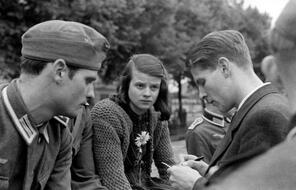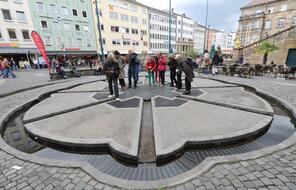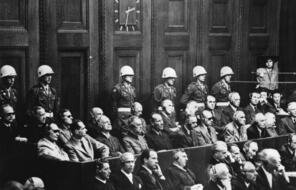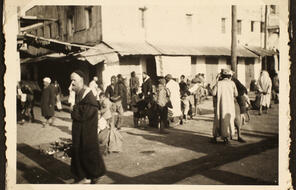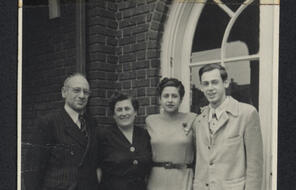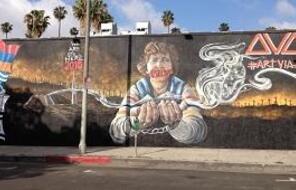Facing the Past in Poland
At a Glance
Language
English — USSubject
- History
- Social Studies
- Human & Civil Rights
- The Holocaust
How should a country remember its past? This universal question has been especially painful and complex in Poland, a country that suffered an extraordinarily brutal German occupation in World War II, followed by decades of Soviet Communist dominance that lasted until 1989. In the years after the war, Poles overwhelmingly viewed themselves as victims of Germany. Nazi ideology had portrayed Poles as subhuman Untermenschen (“inferior people”). During the war, German forces murdered at least 1.9 million non-Jewish Polish civilians and forced 1.5 million others into slave labor. 1 At least 3 million Jewish citizens of Poland were killed in the Holocaust. When the war ended in 1945, Poland’s infrastructure was destroyed, its population was reduced by over 20%, and its capital of Warsaw was in ruins. 2 In their memories of the war years, Poles focused on their suffering, on stories of Polish resistance to German power, and on the heroism of Polish Catholics who risked their own lives to rescue Jews.
In the 1990s, as the era of Communist rule came to an end and Poland made the transition to democracy, new perspectives on Polish experiences in World War II began to emerge. Revisiting the history of the war years and drawing on new research, historians began to portray Poles not only as victims of Nazism but also as collaborators in its crimes. Historian Jan Gross wrote a controversial book, Neighbors, about the 1941 massacre of 1,600 Jewish men, women, and children in the Polish village of Jedwabne. The Jews of Jedwabne were killed not by Germans but by their Polish neighbors. Gross calls his work “a confrontation with ghosts in the consciousness of Polish society.” 3
This type of “confrontation” is painful and controversial. In 2016, as the conservative “Law and Justice” Party came to power in Poland, leaders took steps to emphasize once again the stories of Polish rescuers at new museums and historical sites. Some observers believed that these efforts were motivated not only by the desire to celebrate rescuers’ heroism but also by the wish to counterbalance or even conceal the kind of Polish participation in crimes that Gross describes in his book. 4 Government officials also proposed a new law that would make it a criminal offense to use the phrase “Polish death camps” in reference to German camps like Auschwitz, which were built within the boundaries of German-occupied Poland. 5
Amid these debates about national shame and national pride, some educators and activists are helping young Poles learn something that has been absent from their history lessons: the stories of Jewish life that flourished in their country in the centuries before World War II. Jews once made up about 10% of the Polish population; in some villages, they were a majority of residents. But few Jews live in Poland today, and outside the major cities, traces of Jewish life have disappeared. The Forum for Dialogue, a Polish organization that works to foster relationships between Polish Jews and non-Jews, created a program called the “School of Dialogue” to help Polish young people discover the lost Jewish history of their own hometowns. Forum for Dialogue board member Zuzanna Radzik describes their work:
We come to schools and work to capture the young people’s interest. Together with them, we draw maps of the neighborhood—as it looks today and as it did before the war—so we can find out what the students know about history. Our instructors team up with the students to establish who used to live in the area. That is an opportunity for the young people to learn the meaning of words such as synagogue and mikveh [a bath used for Jewish ritual] and get to know what a Jewish cemetery looks like. In other words, they learn about the social and religious life of Jews. After the classes, the students can come up with their own projects to help commemorate Jewish history.
These projects, Radzik hopes, will help students understand that the Jewish heritage of their town is their history, too. 6
Michael Gawenda, a descendant of Polish Jews who lives in Australia, visited the Polish town of Sandomierz with students from the School of Dialogue in 2013. In an article for the Sydney Morning Herald, he gave a very personal account of what the visit meant to him:
Sandomierz is a beautiful little town in south-eastern Poland surrounded by apple orchards and verdant green fields. Once, before the war, many of its inhabitants were Jews. As we walked along the streets that were once Jewish streets, this group of American and Australian Jews, there were no signs, nothing at all, to suggest that the Jews of Sandomierz had a history going back hundreds of years . . .
The past sat in my heart like a stone. On the once-Jewish streets of Sandomierz, in these well-kept and pastel-coloured apartment buildings, lived Poles. I wondered whether they knew what had happened to the people who once lived here and, if they did know, did the ghosts of the dead Jews ever come to disturb their sleep?
I had not come to Poland to reclaim the past. The past was settled. I had been to Poland in 1985 when the communists were still in control. I came as a journalist and I met Solidarity leaders and leaders of the Polish democracy movement. Poland was alien. I felt no connection with the place. There was nothing to suggest that this had once been the home of millions of Jews, my parents included. I left knowing I would never return.
This time, at the front doors of the high school, we were greeted by the principal who ushered us into the staffroom, where we were offered tea. On the table were plates of Polish biscuits and small cakes. I knew the taste of these biscuits and these cakes.
Outside the room, the students we had come to see were waiting for us. They were holding posters and folios stuffed with papers and some of them were using their phones to take photos of us.
They were 16 and 17 years old and when they stood together at the front of their classrooms, in front of the portraits of Polish patriots who had fought for Polish freedom from the Russian and German occupiers who had divided Poland between them for centuries, I wondered how their parents and their grandparents, in particular, regarded the long-vanished Jews of Sandomierz.
In groups of two or three, the kids held up posters. On them were drawn maps of the streets where the Jews of their town had once lived. Some of the posters were photographs of buildings that had once been Jewish communal centres. Some of the kids leafed through bound folios of typed interviews with local people about the Jews of Sandomierz. What did they know about the Jews? Did they know what had happened to them?
These young people were full of a sort of defiant and boisterous joy, the sort that comes from discovering something that had been hidden from you. Lots of Jews had once lived here! Who were these people? What's a Jew anyway? And why did they leave?
Later, we walked with them through their town and they took us to the new markers of Jewish life in Sandomierz that I had thought did not exist. They stood in the rain to show us the places they had marked on their maps where the Jews had once lived.
They took me, these boys and girls unburdened by guilt or shame, to the archives office, where they had searched out the names of the Jews of their town. This building had once been the synagogue of Sandomierz and on the walls were what I thought were psalms in faded Hebrew lettering. The kids took photographs on their phones and when perhaps I looked too grim, a boy asked me to smile and I did smile and the stone in my heart felt smaller.
The rain came down harder on the walk to the little Jewish cemetery.
The graves were cracked and dirty grey, and in the centre of the cemetery there stood a sort of monument shaped like a pyramid that was constructed of old tombstones.
The kids had cleaned the tombstones and they had cleared the weeds from the paths. A girl called Agata came and stood beside me and asked if I would like to light a remembrance candle with her . . . perhaps I was just imagining this, but it seemed that in that moment, we knew that we were both connected to this place. We stood together in front of a moss-covered grave, the lettering on the tombstone long faded.
Later, at the café where we ate local apples and the cakes the kids had baked for us, Agata asked me how come I understood some Polish words. I told her my parents had spoken Polish when I was a child and they didn't want me to understand what they were saying.
"Where did they come from?" she asked. I told her my mother was from Lodz and my father from a small town called Lowicz.
"So you are Polish,'' she said.
I didn't know what to say. My parents, whose families lived in Poland for many generations, did not consider themselves to be Polish. For them, Poland was no more than a place of death. It was not just the years of genocide that had embittered them, though those years had coloured—and yes, distorted—their view of Poles and Polish anti-Semitism.
"I guess I am Polish in a way,'' I said. "Do you think I am Polish?'' I asked.
"Of course," she said, and smiled.
In schools across Poland, hundreds of kids are working on projects like the one in Sandomierz. I wondered what would last from these discoveries for these children who once had no inkling that Jews had lived in their towns. Their parents had never spoken to them about the Jews of their town. Neither had their grandparents. The communist regime had been determined to rid Poles of any memory of the country's Jews.
But as I travelled on in Poland, with the kids of Sandomierz somehow accompanying me, I thought that the past cannot be undone but perhaps it can be reclaimed. 7
Connection Questions
- Why do you think the Polish government has tried to influence how history should be remembered in Poland?
- What is the purpose of the Forum for Dialogue’s School of Dialogue? What impact did it have on Michael Gawenda? How did it shape his sense of identity and belonging? What impact did the School of Dialogue have on the students Gawenda met?
- What does this reading suggest about the connection between history, national identity, and individual identity?
- What is the value in learning the history of the place where you live, especially if that history is invisible or largely forgotten? What difference might knowing that history make?
- 1“Polish Victims,” United States Holocaust Memorial Museum, last modified January 29, 2016, accessed June 3, 2016.
- 2Piotrowski, Tadeusz, Poland's Holocaust: Ethnic Strife, Collaboration with Occupying Forces and Genocide in the Second Republic, 1918–1947 (Jefferson, NC: McFarland & Company, 1998), 1.
- 3Alex Duval Smith, “Polish move to strip Holocaust expert of award sparks protests,” The Guardian, last modified February 13, 2016, accessed June 3, 2016.
- 4Ofer Aderet, “Polish Museum Honoring Poles Who Saved Jews Arouses Controversy,” Haaretz (Israel), March 22, 2016, accessed June 3, 2016.
- 5“Nazi atrocities: Implying Polish guilt to become crime,” BBC News, last modified February 15, 2016, accessed June 3, 2016.
- 6Katarzyna Kaczmarek, “Promoting Polish-Jewish Dialogue,” Warsaw Voice Online, March 27, 2013, accessed June 3, 2016.
- 7Michael Gawenda, “A Land of Ghosts,” Sydney Morning Herald (Sydney, Australia), January 18, 2014, accessed June 3, 2016. Reproduced by permission from The Sydney Morning Herald.
How to Cite This Reading
Facing History & Ourselves, "Facing the Past in Poland," last updated August 2, 2016.



